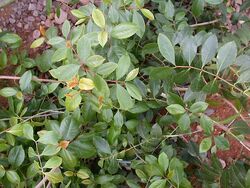Assessment |
Biopsychology |
Comparative |
Cognitive |
Developmental |
Language |
Individual differences |
Personality |
Philosophy |
Social |
Methods |
Statistics |
Clinical |
Educational |
Industrial |
Professional items |
World psychology |
Biological: Behavioural genetics · Evolutionary psychology · Neuroanatomy · Neurochemistry · Neuroendocrinology · Neuroscience · Psychoneuroimmunology · Physiological Psychology · Psychopharmacology (Index, Outline)
|
Cathine chemical structure | |
| 2-amino-1-phenyl-propan-1-ol IUPAC name | |
| CAS number 492-39-7 |
ATC code [[ATC_code_|]][1] |
| PubChem 441457 |
DrugBank [2] |
| Chemical formula | |
| Molecular weight | 151.206 |
| Bioavailability | |
| Metabolism | |
| Elimination half-life | |
| Excretion | |
| Pregnancy category | |
| Legal status | |
| Routes of administration | Chewing Catha edulis leaves. |
- For the alkaloid found in plants such as coffee and tea, see Caffeine.
Cathine (β-hydroxyamphetamine) is a monoamine alkaloid found in the shrub Catha edulis (khat). Closely related to ephedrine, cathinone and other amphetamines, it may contribute to the stimulant effect of Catha edulis, although another constituent, cathinone appears to show stronger activity. Cathine is one of the optical isomers of phenylpropanolamine, an appetite suppressant and decongestant which is possibly associated with an increased risk of hemorrhagic stroke.
The World Anti-Doping Agency's list of prohibited substances (used for the Olympic Games among other athletic events) bars cathine in concentrations of over 5 micrograms per milliliter in urine. Cathine is a Schedule III drug under the Convention on Psychotropic Substances.[1] In the United States, it is classified as a Schedule IV controlled substance.

Cathine is found in shrub Catha edulis.
In Hong Kong, Cathine is regulated under Schedule 1 of Hong Kong's Chapter 134 Dangerous Drugs Ordinance. It can only be used legally by health professionals and for university research purporses. The substance can be be given by pharmacists under a prescription. Anyone who supplies the substance without presciption can be fined $10000(HKD). The penalty for trafficking or manufacturing the substance is a $5,000,000 (Hong Kong dollar) fine and life imprisonment. Possession of the substance for consumption without license from the Department of Health is illegal with a $1,000,000 (HKD) fine and/or 7 years of jail time.
References
See also
- Cathinone
- Methcathinone
- Phenylpropanolamine
- Phenethylamines
External links
| Amphetamines edit |
|---|
|
4-FMP Amphetamine Benzphetamine Dextroamphetamine dl-Amphetamine MDMA MDA MDEA Methamphetamine Paramethoxyamphetamine |
| This page uses Creative Commons Licensed content from Wikipedia (view authors). |